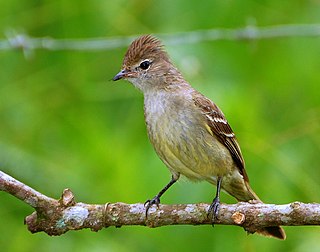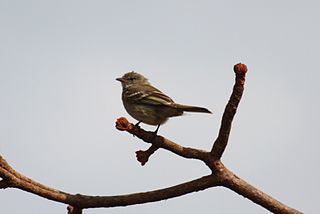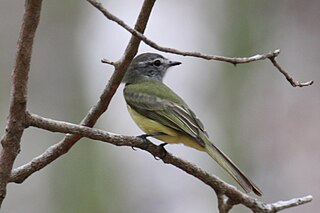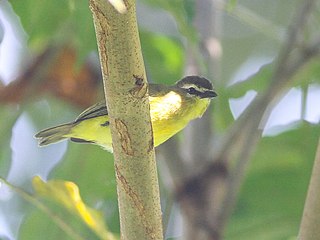
The yellow-bellied elaenia is a small bird in subfamily Elaeniinae of family Tyrannidae, the tyrant flycatchers. It is found in Mexico, in every Central American country, in every mainland South American country except Chile, on Trinidad and Tobago, and on several islands in the Lesser Antilles.

The southern beardless tyrannulet is a small passerine bird in subfamily Elaeniinae of family Tyrannidae, the tyrant flycatchers. It is found in Costa Rica, Panama, in every mainland South American country except Chile, and on Trinidad.

The chestnut-backed antbird is a passerine bird in subfamily Thamnophilinae of family Thamnophilidae, the "typical antbirds". It is found in Colombia, Costa Rica, Ecuador, Honduras, Nicaragua, and Panama.

The yellow tyrannulet is a small passerine bird in subfamily Elaeniinae of family Tyrannidae, the tyrant flycatchers. It is found in Costa Rica, Nicaragua, Panama, and in every mainland South American country except Chile and Uruguay.

The white-crested elaenia is a species of bird in subfamily Elaeniinae of family Tyrannidae, the tyrant flycatchers. It is found in Bolivia, Chile, Colombia, Ecuador, and Peru.

The lesser elaenia is a species of bird in subfamily Elaeniinae of family Tyrannidae, the tyrant flycatchers. It is found in Costa Rica, Panama, on Trinidad, in every mainland South American country except Chile and Uruguay, and as a vagrant on Bonaire and Curaçao.

The plain-crested elaenia is a species of bird in subfamily Elaeniinae of family Tyrannidae, the tyrant flycatchers. It is found in Bolivia, Brazil, Colombia, French Guiana, Guyana, Peru, Suriname, and Venezuela.

The great elaenia is a species of bird in subfamily Elaeniinae of family Tyrannidae, the tyrant flycatchers. It is found in Brazil and Venezuela.

The highland elaenia is a species of bird in subfamily Elaeniinae of family Tyrannidae, the tyrant flycatchers. It is found in Argentina, Bolivia, Ecuador, and Peru.

The sierran elaenia is a species of bird in subfamily Elaeniinae of family Tyrannidae, the tyrant flycatchers. It is found in Bolivia, Colombia, Ecuador, and Peru.

The rufous-crowned elaenia is a species of bird in subfamily Elaeniinae of family Tyrannidae, the tyrant flycatchers. It is found in Brazil, Colombia, French Guiana, Guyana, Suriname, and Venezuela.

The slaty elaenia is a species of bird in subfamily Elaeniinae of family Tyrannidae, the tyrant flycatchers. It is found in Argentina, Bolivia, Colombia, Peru, and Venezuela, and as a vagrant in Ecuador and on Trinidad.

The scaled antpitta is a species of bird in the family Grallariidae. It is found in Bolivia, Brazil, Colombia, Costa Rica, Ecuador, El Salvador, Guatemala, Guyana, Honduras, Mexico, Nicaragua, Panama, Peru, Trinidad and Tobago, and Venezuela.

The white-throated tyrannulet is a species of bird in subfamily Elaeniinae of family Tyrannidae, the tyrant flycatchers. It is found in Argentina, Bolivia, Brazil, Colombia, Ecuador, Peru, and Venezuela.

The foothill elaenia is a species of bird in subfamily Elaeniinae of family Tyrannidae, the tyrant flycatchers. It is found in Colombia, Ecuador, Peru, and Venezuela.

The greenish elaenia is a species of bird in subfamily Elaeniinae of family Tyrannidae, the tyrant flycatchers. It is found in Mexico, every Central American country, and every mainland South American country except Chile and French Guiana. It has also occurred as a vagrant in southern Texas.

The brown-capped tyrannulet is a species of bird in subfamily Elaeniinae of family Tyrannidae, the tyrant flycatchers. It is found in Colombia, Costa Rica, Ecuador, Panama, and Venezuela and reported for the first time in Nicaragua in 2011.

The grey-throated leaftosser is a Near Threatened species of bird in the subfamily Sclerurinae, the leaftossers and miners, of the ovenbird family Furnariidae. It is found in Bolivia, Brazil, Colombia, Costa Rica, Ecuador, Panama, Peru, Trinidad and Tobago, and Venezuela.

The timberline wren is a species of bird in the family Troglodytidae. It is found in Costa Rica and western Panama.

The yellow-crowned tyrannulet is a species of bird in subfamily Elaeniinae of family Tyrannidae, the tyrant flycatchers. It is found in Costa Rica, Panama, and in every mainland South American country except Argentina, Chile, Paraguay, and Uruguay.
























